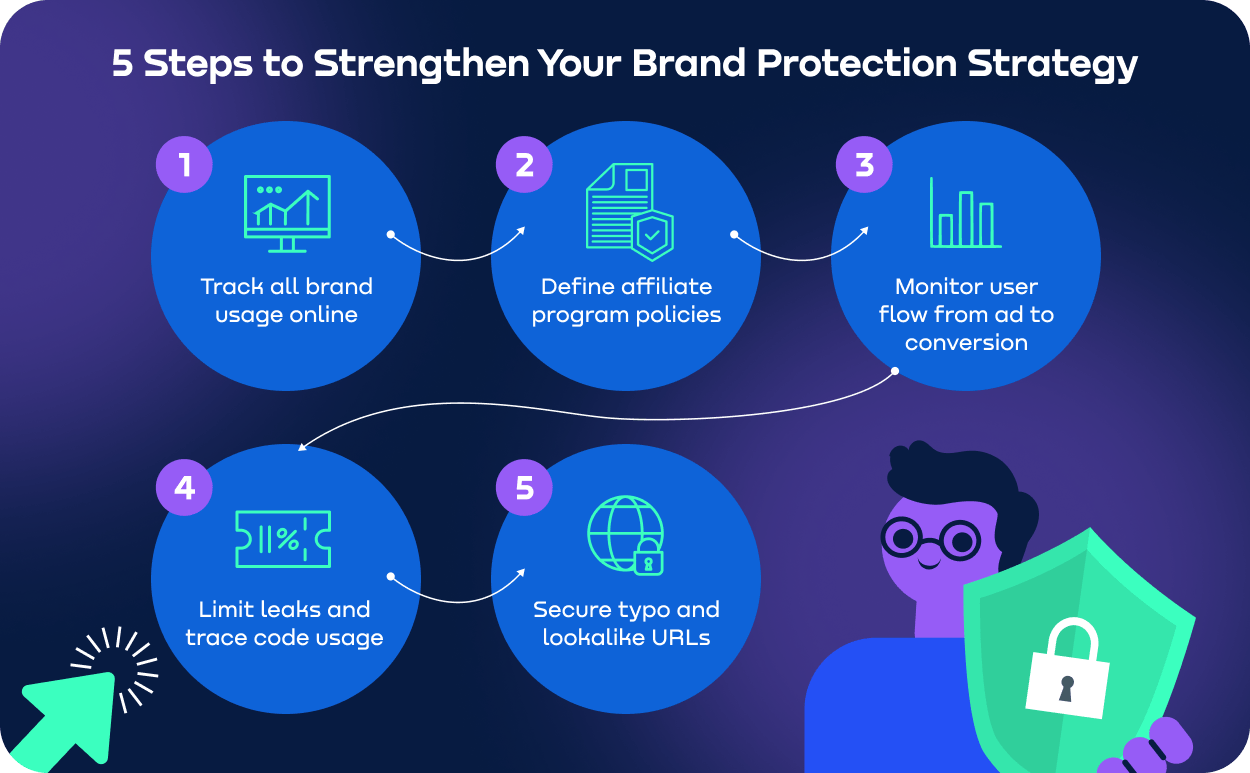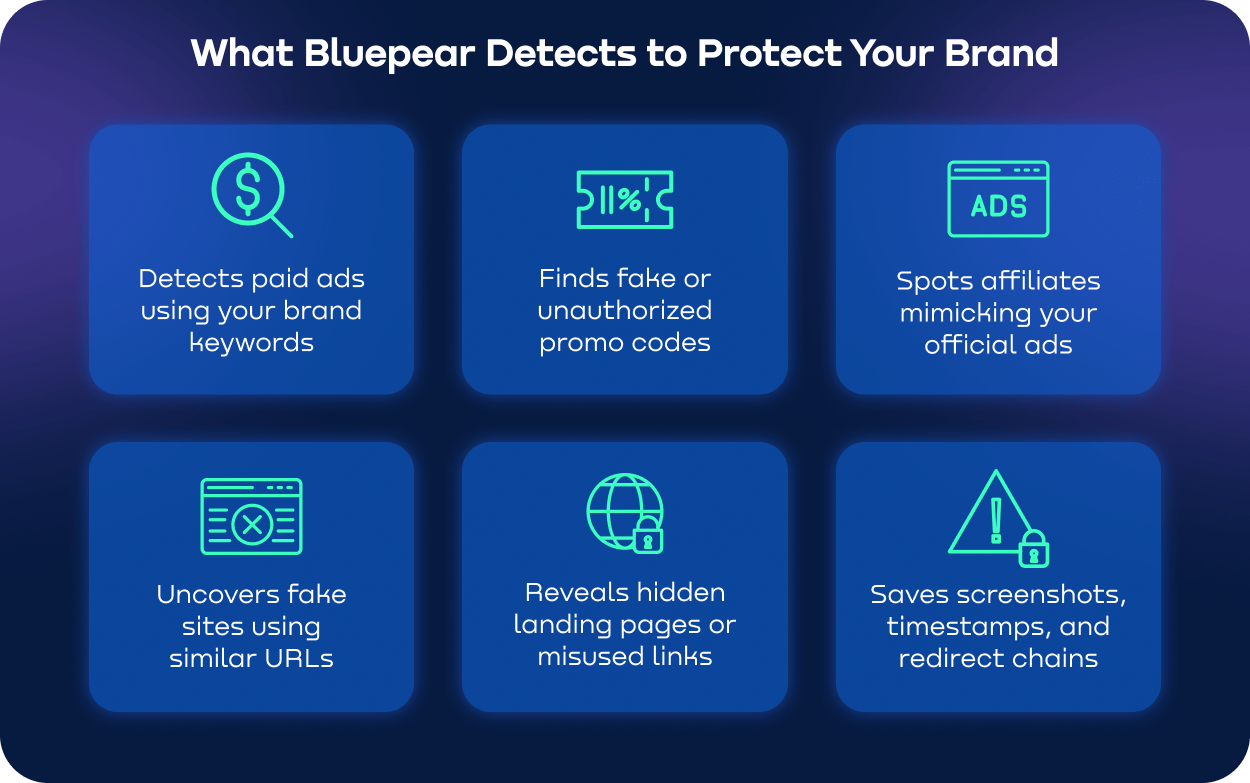
Contents
In 2025, online brand protection is a must. We would not be that dogmatic if fraudsters were not becoming more and more aggressive and inventive. Counterfeits, fake sites, unscrupulous affiliates and competitive brand bidding are no longer a rarity, but a reality for 85% of companies.
Look, no one questions the necessity of marketing campaigns for brand’s success while brand protection strategy is still considered to be something secondary — until the real damage is done. Fraudulent tactics evolve, so should your online brand compliance strategies. Recent statistics prove it — see for yourself:
• According to a report by Rewardful, up to 45% of affiliate traffic could be fraudulent, highlighting the need to implement effective fraud detection and prevention systems.
• More than 50% of companies believe that fraud is holding back their business growth, and 37% report a decrease in customer loyalty due to fraud incidents.
• Around 30% of brands report instances of fraud, such as cookie stuffing and false chargebacks, used by unscrupulous affiliates to artificially inflate their commissions.

Fortunately, there are ways of brand protection that help to fight against fraudsters effectively. Let’s learn more about modern tools and strategies for online brand protection.
Why Online Brand Protection Is More Important Than Ever
Today, there are plenty of fraudulent techniques. To choose the right brand protection strategy, you need to know how exactly each of them is performed. Let’s dive into details and see some real-life examples:
Affiliate program violations. Unscrupulous affiliates use prohibited ways of promoting your brand, bid on branded keywords, offer fake discounts or promo codes. They may also steal your organic traffic and use cloaked websites to hide the violations.
Example: An electronics brand discovered that several affiliates were directing users to lookalike landing pages offering fake “exclusive promo codes.” The brand was paying commissions on stolen traffic it would have received organically — while users reported confusion and mistrust when the codes didn’t work.
Brand bidding. Affiliates and competitors bid on your keywords and take top positions in your branded search results. CPCs go up, while CTR becomes lower. Without brand bidding protection, potential clients see your competitors’ ads and purchase their products instead of yours.
Example: A fashion retailer noticed a sharp spike in CPC for its own branded terms. Upon review, several direct competitors were aggressively bidding on these keywords. Their ads appeared above the brand’s own in Google Search.
Fake websites and phishing. Fraudsters create websites that look like some brand’s official website. They do it to steal users’ personal data and banking information. This way brands lose customers and face legal risks.
Example: In 2023, Bolster AI identified over 6,000 phishing sites impersonating 100+ major brands, from banks to online retailers. One of them was a DHL lookalike site that was used to steal personal information of the brand’s clients.
Trademark abuse. Online trademark infringement happens when someone uses your brand’s identity elements without permission. Affiliate partners may use your trademark in their ads which do not always comply with your messaging policies or affiliate program rules.
Example: A travel company discovered that several affiliate partners were using its registered brand name in Google Ads without approval. These ads led to low-quality landing pages. So, the brand had no control over the messaging or user experience. The trademark abuse led to negative user experience and damaged the brand’s reputation.
URL hijacking. This happens when someone registers a domain that looks almost identical to your brand’s URL. Minor misspellings or extra words are used to trick users. The goal is to steal traffic and monetize it without your consent.
Example: An electronics retailer noticed increased support tickets from customers who claimed they never received their orders. The company found that a domain like brandnamee.com (instead of the official brandname.com) collected payments, then disappeared — leaving frustrated customers blaming the real brand.
If brands do not take proactive steps to ensure online brand compliance, there may occur some consequences:
• Direct financial losses. Brands lose money because of stolen traffic, fraud, falling sales.
• Loss of customer trust. Users do not distinguish between you and a fake and blame the brand for poor quality or even fraud.
• Increasing marketing costs. You have to “buy back” your positions in the search results due to poor brand bidding protection.
• Legal and regulatory risks. This is especially relevant for products with a high level of control (gambling, fintech, pharma).
• Distortion of data. When analytics data is skewed, decisions become ineffective.
So, online brand protection is vital for brands that seek to keep their budgets and reputation under control.
Why Standard Brand Protection Online Fails in 2025
Unscrupulous affiliates and competitors have not just learned to abuse brands. They have learned to stay one step ahead using techniques that can easily bypass standard checks.
Unfortunately, manual monitoring is not a sufficient brand protection strategy anymore. What you see on your screen is often very different from what your users see elsewhere. Here’s why:
• Cloaking. Content shown to users is different from what brand managers or ad reviewers see. You think it’s a clean landing page, but users get misleading or non-compliant offers.
• Geo-targeting. Some violations only show up in specific countries. You might be based in the UK, while the fraud is happening in Brazil or Indonesia — and you’d never know without a brand protection program.
• Dayparting. Some affiliates run problematic campaigns at night or during weekends when no one from the brand team is watching.
• Browser fingerprinting. The page behavior changes based on who’s visiting (brand IPs get clean versions, others see the tricks).
That’s why brands today need a proper brand protection strategy and automated monitoring solutions. It sees what you can’t across regions, time zones, and devices. Modern ways of brand protection give you back control before reputational or financial damage is done.
Building a Digital Shield: Steps for Brand Protection Online
Here’s a step-by-step guide for effective online brand protection:
Step 1. Continuously monitor your online brand compliance. Set up an automated brand protection program to track all mentions of your brand across search engines, paid ads, landing pages, and social media.
Step 2. Create strict affiliate program policies. Make sure your partners know the rules on brand bidding, domain use, and promo code distribution. Enforce penalties for violations.
Step 3. Use a brand protection program to monitor the full user path from click to conversion. Look out for cloaking, fake offers, or off-brand experiences that hurt user trust to ensure online brand safety.
Step 4. Limit the use of discount codes and track where they appear. Fake or leaked promo codes can attract the wrong traffic and damage pricing strategy.
Step 5. Buy domain variations of your brand name — common typos, plural forms, etc. This helps prevent URL hijacking and keeps bad actors from impersonating your site.

How Bluepear Strengthens Online Brand Protection Strategies
Bluepear is an automated search monitoring tool that ensures online brand compliance. The brand protection program 24/7 tracks your branded SERPs and sends you alerts when any violations are detected.
Let’s see how Bluepear can enhance your brand protection strategy:
• Bluepear detects unauthorized use of branded keywords, suspicious promo codes, and cloaked redirects that would otherwise slip past manual checks.
• When affiliates or competitors bid on your brand terms, Bluepear catches it in real time. It identifies which keywords were used, where the ads were shown, and who’s behind them — even if the violator tries to hide.
• Bluepear spots unauthorized sites mimicking your brand, often using typosquatted domains or deceptive redirects.
• Bluepear flags all unapproved uses of your brand identity — from misleading ad creatives to brand mentions on coupon aggregators,
• Bluepear tracks organic search results for cloned or hijacked domains. It uncovers when fake URLs outrank your site and intercept traffic meant for you.

Your brand’s digital presence is too valuable to leave unprotected. With cloaking, brand bidding, and affiliate abuse evolving every day, reactive monitoring is no longer enough. Bluepear gives you an always-on, evidence-backed monitoring system that protects your brand in search.

